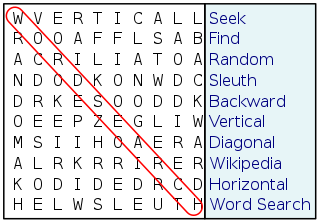Word games are spoken, board, card or video games often designed to test ability with language or to explore its properties.

A crossword is a word game consisting of a grid of black and white squares, into which solvers enter words or phrases ("entries") crossing each other horizontally ("across") and vertically ("down") according to a set of clues. Each white square is typically filled with one letter, while the black squares are used to separate entries. The first white square in each entry is typically numbered to correspond to its clue.

A cryptic crossword is a crossword puzzle in which each clue is a word puzzle. Cryptic crosswords are particularly popular in the United Kingdom, where they originated, as well as Ireland, the Netherlands, and in several Commonwealth nations, including Australia, Canada, India, Kenya, Malta, New Zealand, and South Africa. Compilers of cryptic crosswords are commonly called setters in the UK and constructors in the US. Particularly in the UK, a distinction may be made between cryptics and quick crosswords, and sometimes two sets of clues are given for a single puzzle grid.
Cliff Johnson is an American game designer, best known for the puzzle video games The Fool's Errand (1987) and 3 in Three (1990). Both games use visual puzzles and a metapuzzle structure. Both won GAMES Magazine's Best Puzzle Game of the Year.

The Fool's Errand is a 1987 computer game by Cliff Johnson. It is a meta-puzzle game with storytelling, visual puzzles, and a cryptic treasure map. It is the tale of a wandering Fool who seeks his fortune in the Land of Tarot and braves the enchantments of the High Priestess. A sequel titled The Fool and His Money was released October 25, 2012.

Uninvited is a black-and-white horror-themed point-and-click adventure game. It was originally developed for the Macintosh by ICOM Simulations released in 1986 by Mindscape as part of the MacVenture series.

A word search, word find, word seek, word sleuth or mystery word puzzle is a word game that consists of the letters of words placed in a grid, which usually has a rectangular or square shape. The objective of this puzzle is to find and mark all the words hidden inside the box. The words may be placed horizontally, vertically, or diagonally. Often a list of the hidden words is provided, but more challenging puzzles may not provide a list. Many word search puzzles have a theme to which all the hidden words are related such as food, animals, or colors. The puzzles have, like crosswords and arrowords, become very popular. Also in common with these latter puzzles, have had complete books and mobile applications devoted to them.

The Colony is a first-person shooter developed by David Alan Smith. It was published by Mindscape.

Fill-Ins, also known as Fill-It-Ins or Word Fill-Ins, are a variation of the common crossword puzzle in which words, rather than clues, are given, and the solver must work out where to place them. Fill-Ins are common in puzzle magazines along with word searches, cryptograms, and other logic puzzles. Some people consider Fill-Ins to be an easier version of the crossword. Since the Fill-In requires no outside knowledge of specific subjects, one can solve the puzzle in another language.

3 in Three is a 1989 metapuzzle video game designed by Cliff Johnson and published by Cinemaware and Inline Design.
Games World of Puzzles is an American games and puzzle magazine. Originally the merger of two other puzzle magazines spun off from its parent publication Games magazine in the early 1990s, Games World of Puzzles was reunited with Games in October 2014.
A metapuzzle, also known as a meta-puzzle or meta, is a puzzle that uses the solutions to a set of puzzles to create or provide data for a final puzzle.

Shadows of Mordor: Game Two of Lord of the Rings is a text adventure game for the Commodore 64, Amstrad CPC, ZX Spectrum, Apple II, DOS, and Macintosh. It is based on the second part of The Lord of the Rings story. It's a sequel to Lord of the Rings: Game One and The Hobbit.

The New York Times crossword is a daily American-style crossword puzzle published in The New York Times, syndicated to more than 300 other newspapers and journals, and released online on the newspaper's website and mobile apps as part of The New York Times Games.

Lord of the Rings: Game One is a video game released in 1985 and based on the book The Fellowship of the Ring, by J. R. R. Tolkien. It was the follow-up to the 1982 game The Hobbit, but did not reach the same level of critical success as its predecessor. It's generally considered inferior by the gaming community, with many complaining about the removal of the real-time aspects and complex AI patterns of the previous game, and puzzles that lacked coherent solutions. To promote the game, Melbourne House commissioned hologram picture of a Nazgûl from a company called Holographix. It was available to purchase from Melbourne House directly using an order form on the instruction booklet included with the game. A sequel, Shadows of Mordor: Game Two of Lord of the Rings, was released in 1987.

Ishido: The Way of Stones is a puzzle video game released in 1990 by Accolade and developed by Publishing International. It was designed by Michael Feinberg and programmed by Ian Gilman and Michael Sandige. The game's producer was Brad Fregger, and Brodie Lockard contributed with graphics.

Welltris is a puzzle video game, developed by Doca and licensed to Bullet-Proof Software. It is an official game in the Tetris series. Adaptations were made by Sphere, Inc., for Spectrum HoloByte, and by Infogrames. It was released for MS-DOS compatible operating systems in 1989. Ports for Macintosh, Amiga, Amstrad CPC, and Atari ST followed 1990, then ZX Spectrum and Commodore 64 1991.

Balance of the Planet is a simulation video game developed by Chris Crawford. He self-published it in 1990 for Macintosh. It was ported to MS-DOS and PC-98.
XOR Corporation was a video game developer and publisher based in Minnetonka, Minnesota, founded in 1982 by Glenn Diamond. XOR was active until 1990 and primarily released games for DOS and Macintosh, but also released the DOS business applications Blu Chip, a stock portfolio manager, and Thoth, a database manager, and the C utility C Tools.














